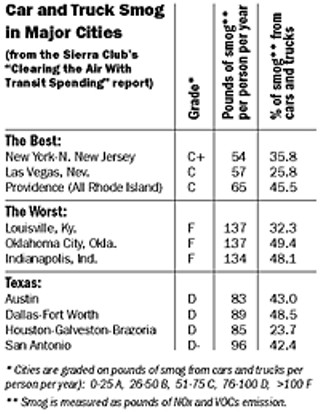Subsidizing Smog
A new report from the Sierra Club shows that while new roads may get traffic moving, air quality will continue to suffer.
By Dan Oko, Fri., Nov. 30, 2001

It's not the sort of thing Austinites will want to hear in the wake of voters passing a $185 million road bond package this month, but a new report from the Sierra Club shows that while new roads may get traffic moving, air quality will continue to suffer. According to "Clearing the Air With Transit Spending," released in mid-November by the environmental group's national office, suburban-style development and a continued focus on private transportation threaten not just livability but human health in most of America's large cities -- including Austin, San Antonio, Dallas, and Houston. Specifically, the report shows a correlation between high levels of smog in those cities that lack public-transportation spending and suffer from poor urban planning.
The Sierra Club concludes that rather than building more roads, Austin and other municipalities would be better off limiting sprawl, increasing opportunities for pedestrian and bicycle travel, and improving public transit systems. Not surprisingly, given that Texans tend to still view the car as king, the Lone Star State did not fare well in the report. Statewide, Texas spent $273.21 per person on highways and a mere $76.53 on public transit; for every $100 dollars spent on public transportation in Texas, $357 was spent on highways.
As for Austin -- despite its hike-and-bike trails, ozone-warning days, and Capital Metro, our city got lousy grades on the report (a mixture of Ds and Fs) in categories such as overall public transportation spending and relative level of air pollution from private vehicles.
According to the report, even before Election Day, Capital City spending was heavily skewed toward highways rather than public transportation, with less than $40 spent on the latter for every $100 spent on the former. Adding insult to injury, according to local Sierra Club representatives, despite the city's Smart Growth initiatives, planners have not done enough to encourage the sorts of developments that could offset the subdivisions that threaten Austin's outskirts. "Our air quality is not getting better," says Dick Kallerman, the chair of the Sierra Club's local transportation committee, "and we have not done anything to make it better. In the last 20 years, the population has grown 60%, and at the same time we've doubled the number of road lanes. We're generating our demise by forcing people to drive."
The number presented in the report that may be most disconcerting for those of us who breathe the air is that for every resident of Austin, individual cars and trucks produce 83 pounds of smog per person each year. What is called "smog" is essentially a toxic combination of nitrogen oxides and volatile organic compounds that have been identified as exacerbating respiratory illnesses, including asthma, as well as having potential carcinogenic or cancer-causing effects when inhaled. More than 40% of the smog in Austin comes from the tailpipes of private vehicles.
Sierra Clubbers are not alone in warning that Austin must shake its automotive addictions. At the University of Texas, Kara Kockelman, an assistant professor of civil engineering who has studied traffic patterns extensively, says it's unlikely Austin will be able to "build [itself] out of congestion." Noting that state transportation officials have little control over zoning issues, Kockelman says city planners and local transit administrators must develop a transportation infrastructure that supports Smart Growth initiatives such as infill and mixed-use developments, zoned for commercial and residential uses. "We're really running out of time here," Kockelman says.
The Real Estate Council of Austin, which supported all the Travis County bond proposals in the last election, is taking the Sierra Club's findings in stride. RECA's Executive Director Janice Cartwright said RECA "is on record in support of the implementation of a truly regional and multi-modal transportation system for Central Texas that includes major highways, toll roads, and other roadway projects; HOV lanes; possible bus rapid transit options; fixed guideway or other forms of light rail transportation; a conventional bus system that is effective, affordable, and economically viable."
Where RECA and the environmentalists disagree, of course, is in the emphasis on roads in this prescription. And they also disagree about whether easing congestion will decrease smog: The Sierra Club argues that even flowing traffic significantly threatens air quality in Austin, while Cartwright suggests that emissions from idling cars is the main concern. A full copy of the report is available at www.sierraclub.org/sprawl/report01/.
Got something to say on the subject? Send a letter to the editor.








